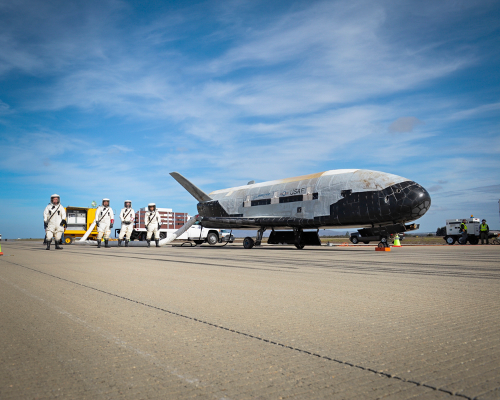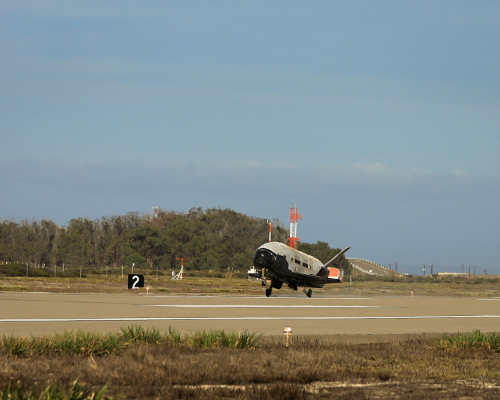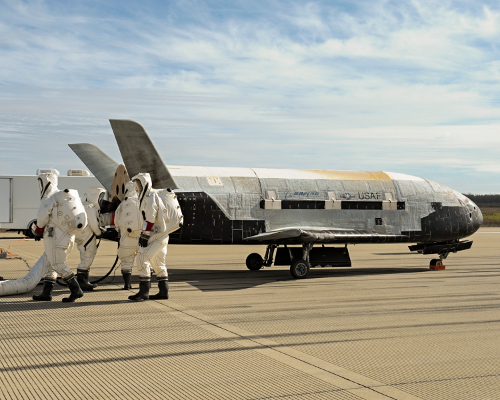
The U.S. Air Force’s mysterious X-37B Orbital Test Vehicle (OTV) ended its third secretive mission today, landing at Vandenberg Air Force Base in Southern California at 9:24 a.m. PDT after spending 674 days in orbit carrying out its secretive mission for the U.S. Air Force Rapid Capabilities Office. Although the Boeing-made X-37B’s existence is public knowledge, its precise mission objectives and ultimate capabilities remain heavily classified.
“We congratulate the Air Force Rapid Capabilities Office and the 30th Space Wing at Vandenberg Air Force Base on this third successful OTV mission,” said Ken Torok, Boeing director of Experimental Systems. “With a program total of 1,367 days on orbit over three missions, these agile and powerful small space vehicles have completed more days on orbit than all 135 Space Shuttle missions combined, which total 1,334 days. The innovative X-37B combines the best of an aircraft and a spacecraft into an affordable, responsive unmanned vehicle and continues to demonstrate that reusable space vehicles are affordable options that support vital missions.”

Described as “the United States’ newest and most advanced re-entry spacecraft,” the OTV’s close resemblance to the shuttle is misleading. In orbit, it deploys an array of gallium arsenide solar cells, which, when combined with power from a set of lithium-ion batteries, have thus far enabled it to remain aloft years longer than any shuttle mission. Its payload bay measures 7 feet long and 4 feet wide and can house a payload weighing between 500-660 pounds. An advanced avionics suite and airframe, together with electromechanical actuators and autonomous guidance controls, has focused the OTV’s mandate onto “risk reduction, experimentation, and operational concept development for reusable vehicle technologies in support of long-term developmental space objectives.”
“I think it is primarily an ISR (Intelligence, Surveillance and Reconnaissance) platform for testing new sensor technologies or validating new technologies,” said retired U.S. Air Force Space Command officer Brian Weeden. “The current vehicle on orbit has basically been in the same orbit since launch, with only the occasional maneuver to maintain that orbit. That’s consistent with a remote sensing/ISR mission.”
The spacecraft’s thermal protection materials are impressive … and so are their acronyms: Toughened Uni-piece Fibrous Refractory Oxidation-resistant Ceramic (TUFROC) tiles line the leading edges of the wings, instead of the reinforced carbon-carbon used on the shuttle, whilst highly durable Toughened Uni-piece Fibrous Insulation (TUFI) impregnated silica tiles and Advanced Conformal Reusable Insulation (CRI) blankets cover the airframe.
“Technologies being tested in the program include advanced guidance, navigation and control, thermal protection systems, avionics, high temperature structures and seals, conformal reusable insulation, lightweight electromechanical flight systems, and autonomous orbital flight, re-entry and landing,” added Weeden.
VIDEO: The X-37B Orbital Test Vehicle mission 3 (OTV-3), the Air Force’s unmanned, reusable space plane, landed at Vandenberg Air Force Base at 9:24 a.m. Oct. 17 .
Although the mission ended at Vandenberg, it launched from Florida’s Cape Canaveral Air Force Station, and it will call neighboring Kennedy Space Center (KSC) home in the coming months, as last week NASA announced that the remaining two space shuttle Orbiter Processing Facilities (or OPFs) at KSC will now be used to process the reusable unmanned space plane for its future missions.
“Kennedy is positioning itself for the future, transitioning to a multi-user launch facility for both commercial and government customers, while embarking on NASA’s new deep-space exploration plans,” said Kennedy Center Director Robert Cabana. “A dynamic infrastructure is taking shape, designed to host many kinds of spacecraft and rockets.”

NASA utilized three OPFs to support processing the agency’s now-retired space shuttle fleet over the course of the 30-year space shuttle program, but the agency has been hard pressed to find a mission requirement for the facilities since the last shuttle landed in 2011. Boeing is already leasing former OPF-3 to manufacture and process their CST-100 spacecraft, and now Boeing is also performing construction upgrades in OPF-1 and OPF-2 on behalf of the X-37B Program, with the upgrades expected to be completed in December.
Like the Soviet-era Buran vehicle, the OTV has the capacity to land autonomously on a runway at either Edwards or Vandenberg Air Force Bases in California. The X-37B Program has also conducted testing at KSC’s Shuttle Landing Facility to demonstrate that landing the vehicle at the former shuttle runway is a technically feasible option.
The Air Force currently has two X-37B vehicles, and the launch of OTV-3 in December 2012 marked the first occasion in which an OTV has ever been used for a second mission. It previously flew for 224 days in April-December 2010, and a sister ship flew the OTV-2 mission for 468 days from March 2011 until mid-June of 2012.
“I’m extremely proud of our team for coming together to execute this third safe and successful landing,” said Col Keith Balts, 30th Space Wing commander. “Everyone from our on console space operators to our airfield managers and civil engineers take pride in this unique mission and exemplify excellence during its execution.”
The Air Force is preparing to launch the fourth X-37B mission from Cape Canaveral Air Force Station some time in 2015.
— Written by both Ben Evans and Mike Killian.
Want to keep up-to-date with all things space? Be sure to “LIKE” AmericaSpace on Facebook and follow us on Twitter: @AmericaSpace
Missions » Air Force OTV »




Why is the highly classified military project getting so much press? I can’t find out its capabilities, what tech it has, what it is used for…Being a X-37…means experimental right…seems like there should be no press at all…Why bother?
Maybe because it’s one of only four Earth’s ships capable return on the ground safely. That alone seems to me like enough reason to bother 🙂
slappy,
What are the other 3? So just because it lands like the shuttle which it did 150 times its a big deal? Or because it landed in one piece and considering the truly uneventful state the US Space Program is in ….Any news is good news?
The other three are russian Soyuz, China’s Shenzhou and SpaceX’s Dragon. Well i guess it depends how hard-kosmo-fan you are. Somebody is moved with pretty much every rocket launch. Somebody doesn’t care even about those mindblowing pictures of 67p from Rosetta.. News about X37 have same importance for me as those about european IXV, chineese ChangE5 test return-flight this weekend and Orion test flight. They all are experimental missions testing new tech or at least how old tech works in new circumstances..
Slappy,
I agree those Pictures of Rosetta are awesome…Set one as my screen background!
On a another note maybe its good to see that we have the Military guys in the full protective gear so we feel better about taking on the Ebola Virus…
Boeing and the Air Force can use positive publicity Even when details are unwise to say